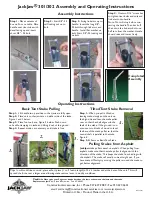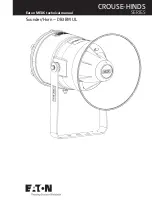
12
2.0 SYSTEM USE
2.1
RESCUE PLAN: When using this equipment and connecting subsystem(s), the employer must have a rescue plan and the
means at hand to implement and communicate that plan to users
3
, authorized persons
4
, and rescuers
5
.
2.2
INSPECTION FREQUENCY: The Full Body Harness shall be inspected by the user before each use and by a competent
person
6
other than the user at intervals of no more than one year
7
. Inspection procedures are described in the
“Inspection
and Maintenance Log”
. Results of each Competent Person inspection should be recorded on copies of the
“Inspection and
Maintenance Log”
or tracked with a Radio Frequency Identification (RFID) system (see
“Inspection”
).
2.3
COMPATIBILITY OF COMPONENTS:
3M equipment is designed for use with 3M approved components and subsystems
only. Substitutions or replacements made with non-approved components or subsystems may jeopardize compatibility of
equipment and may effect the safety and reliability of the complete system.
2.4
COMPATIBILITY OF CONNECTORS: Connectors are compatible with connecting elements when they have been
designed to work together in such a way that their sizes and shapes do not cause their gate mechanisms to inadvertently
open regardless of how they become oriented. Contact Capital Safety if you have any questions about compatibility.
Connectors (hooks, carabiners, and D-Rings) must be capable of supporting at least 5,000 lbs. (22.2 kN). Connectors
must be compatible with the anchorage or other system components. Do not use equipment that is not compatible.
Non-compatible connectors may unintentionally disengage (See Figure 5). Connectors must be compatible in size, shape,
and strength. If the connecting element to which a snap hook (shown) or carabiner attaches is undersized or irregular in
shape, a situation could occur where the connecting element applies a force to the gate of the snap hook or carabiner.
This force may cause the gate (of either a self-locking or a non-locking snap hook) to open, allowing the snap hook or
carabiner to disengage from the connecting point. Self-locking snap hooks and carabiners are required.
2.5
MAKING CONNECTIONS:
Use only self-locking snap hooks and carabiners with this equipment. Use only connectors that
are suitable for each application. Ensure all connections are compatible in size, shape and strength. Do not use equipment
that is not compatible. Ensure all connectors are fully closed and locked.
3M connectors (snap hooks and carabiners) are designed to be used only as specified in each product’s user’s instructions.
See Figure 6 for inappropriate connections. 3M snap hooks and carabiners should not be connected:
A.
To a D-Ring to which another connector is attached.
B.
In a manner that would result in a load on the gate.
C.
In a false engagement, where features that protrude from the snap hook or carabiner catch on the anchor, and
without visual confirmation seems to be fully engaged to the anchor point.
D.
To each other.
E.
Directly to webbing or rope lanyard or tie-back (unless the manufacturer’s instructions for both the lanyard and
connector specifically allows such a connection).
F.
To any object which is shaped or dimensioned such that the snap hook or carabiner will not close and lock, or that
roll-out could occur.
G.
In a manner that does not allow the connector to align properly while under load.
2.6
CONNECTING SUBSYSTEMS: Connecting subsystems (self-retracting lifeline, lanyard, rope grab and lifeline, cable sleeve,
etc.) must be suitable for your application (See section 1.1). See the subsystem manufacturer’s instructions for additional
information. Some harness models have web loop connection points. Do not use snap hooks to connect to web loops. Use
a self-locking carabiner to connect to a web loop. Ensure the carabiner cannot cross-gate load (load against the gate rather
than along the major axis of the carabiner). Some lanyards are designed to choke onto a web loop to provide a compatible
connection. Lanyards may be sewn directly to the web loop forming a permanent connection. Do not make multiple
connections onto one web loop, unless choking two lanyards onto a properly sized web loop. To choke the lanyard on a web
loop (Figure 7): A) Insert the lanyard web loop through the web loop or D-Ring on the harness. B) Insert the appropriate
end of the lanyard through the lanyard web loop. C) Pull the lanyard through the connecting web loop to secure.
2.7
LANYARD PARKING ATTACHMENT: Figure 8 illustrates Lanyard Parking. The Lanyard Parking Attachment is for
attaching the free end of a Lanyard or harness mounted Self-Retracting Device when not connected to an Anchorage
Connection Point for purposes of fall protection. Lanyard Parking Attachments must never be used as a Fall Protection
Attachment Element on the Harness for connecting a Lanyard or Self-Retracting Device (A).
When not connected to an Anchorage Connection Point, an unconnected Lanyard Leg must be properly parked on the
harness (B) or secured in the user’s hand as in 100% Tie-Off applications (C). Free hanging Lanyard Legs (D) can trip the
user or catch on surrounding objects resulting in a fall.
3 User: A person who performs activities at heights while protected by a personal fall protection system.
4 Authorized Person: A person assigned by the employer to perform duties at a location where the person will be exposed to a fall hazard.
5 Rescuer: Person or persons other than the rescue subject acting to perform an assisted rescue by operation of a rescue system.
6 Competent Person: One who is capable of identifying existing and predictable hazards in the surroundings or working conditions which are unsanitary, hazardous, or
dangerous to employees, and who has authorization to take prompt corrective measures to eliminate them.
7 Inspection Frequency: Extreme working conditions (harsh environments, prolonged use, etc.) may require increasing the frequency of competent person inspections.
Summary of Contents for DBI Sala EXOFIT
Page 3: ...3 2 A B C D E F 3 4 C B A FC B C FC 5 6 A B C 7 A B C ...
Page 4: ...4 8 A ü B ü C D 9 10 1 A CLICK B C 2 A B ...
Page 5: ...5 11 A B C D E ...
Page 6: ...6 12 13 1 2 3 4 5 6 ...
Page 7: ...7 14 ...
Page 8: ...8 ...
Page 16: ...16 ...










































